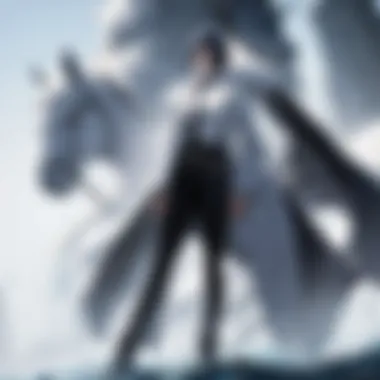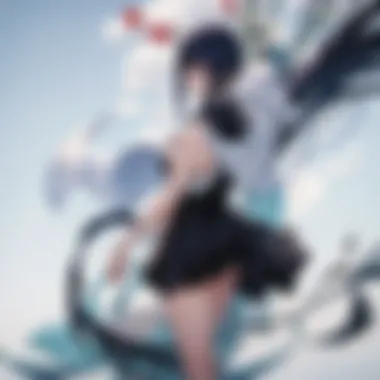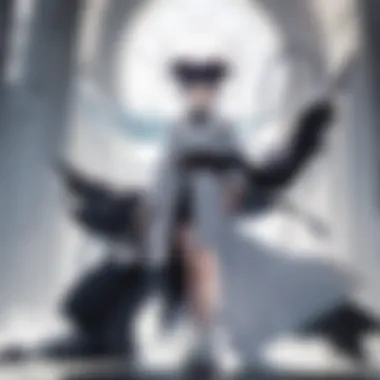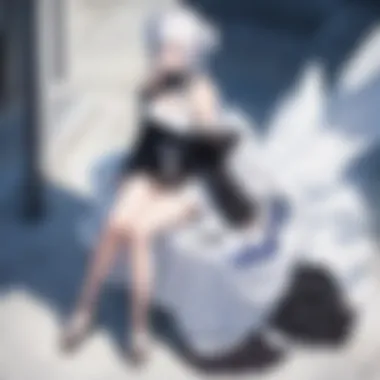The Ultimate Guide to Watching Bleach in the Right Order


Intro
The Bleach anime series is an iconic work in the landscape of animated storytelling. Since its debut, it has captivated a diverse audience with its engaging narrative and complex character development. This article aims to clarify the viewing order of the series, making the experience manageable for both new viewers and longtime fans. Understanding how to navigate its many arcs, episodes, and supplementary materials is essential to grasp the complete world where heroes and villains alike come to life.
Next, viewers will find an overview of the anime series itself, delving into its plot, themes, and notable aspects.
Anime Series Overview
Bleach follows the journey of Ichigo Kurosaki, a teenager with the unique ability to see ghosts. When he unexpectedly gains the powers of a Soul Reaper, he becomes entangled in the battle against evil spirits known as Hollows and other formidable foes within the spiritual realm. At its core, the series explores themes of duty, sacrifice, and the struggles of identity, set against a backdrop of rich world-building and lore.
The visual style of Bleach is distinct, featuring detailed character designs and dynamic fight scenes that resonate with the high stakes of its plot. The vibrant and immersive soundtrack enhances emotional moments and matches the intensity of battles, creating a well-rounded sensory experience for the audience. Some iconic episodes stand out, particularly those that highlight pivotal character moments and spectacular battles, solidifying Bleach as a great work.
Main characters in Bleach include not only Ichigo but also his friends and allies like Rukia Kuchiki, Orihime Inoue, and Uryu Ishida. Each character undergoes significant development, which contributes greatly to their relationships and the overall narrative. The interactions between Ichigo and Rukia, forninstance, are especially meaningful as they evolve throughout the series.
The development of supporting characters, such as Renji Abarai and Byakuya Kuchiki, further layers the complex undelying web of connections that hold the series together.
Character Analysis
The foundation of Bleach resides in its characters. Ichigo's personality reflects determination and courage, often placed opposite the calm demeanor of Rukia. Their contrasting styles showcase the diversity of motivations throughout the narrative. Rukia, with her own struggles, pushes viewers to relate to her sense of lost duty.
Some prominent relationships are:
- Ichigo and Rukia: Expanding from long-time friends to unlikely partners.
- Ichigo and Uryu: A relationship built from initial friction that evolves into respect and camaraderie.
- Renji and Rukia: A bond testing loyalty and friendship through constant challenges.
Fan theories enrich viewer engagement. Many debates center on Ichigo's bloodline and its jeopardization of peace in a world dominated by power struggles. Such complexities enhance thrilling narratives.
Genre Spotlight
Bleach is firmly positioned within the action-fantasy genre, itself an evolving landscape in anime. This genre caters to audiences who appreciate dynamic combat sequences coupled with mythical elements. Action-fantasy often provides moral complexity and intricate lore, as shown in Bleach, combining engaging narratives with thrilling action.
The history of action-fantasy can be traced back to early influential series like Dragon Ball and Yu Yu Hakusho, which paved the way for the genre’s growth. Bleach stands out with its unique appeal, combining combat philosophies, distinct artistic styles, and complex character arcs.
Notable Bleach series characteristics include action-packed episodes, fighting styles founded in both tactics and spirituality, and a rich tapestry woven through characters' motivations.
Behind-the-Scenes Insights
The production of Bleach illustrates a significant vision that was turned into reality through dedicated talent. From storyboarding to final animation, many elements converge to create a successful adaptation. The initial episodes received significant attention, paving the way for high standards in animation and storytelling.
However, some challenges arose throughout production. Creatives experienced issues translating long-spanning manga content into coherent animated stories. Viewers noted pacing difficulties, particularly when connecting major arcs.
Success factors included a strong source material, skilled directors, and talented voice actors that brought characters to life. The result is a series that has built a strong legacy in anime history.
Integrating these diverse elements not only enriches the experience but also equips audience members with deeper appreciation understanding about all Bleach arcs and viewing orders.
Preface to Bleach
The introduction to Bleach highlights the crux of why viewers should consider its unique narrative structure and character arcs. As a complex anime series, Bleach blends supernatural elements with deep emotional storylines and exciting action sequences. Understanding its background is the first step toward fully appreciating the unfolding saga.
Overview of the Series
Bleach, created by Tite Kubo, premiered in 2004 and swiftly garnered a large fanbase. The story revolves around Ichigo Kurosaki, a high school student endowed with the powers of a Soul Reaper. His role involves defending the living world from malevolent spirits, known as Hollows, while also guiding souls to the afterlife.


Over its course, Bleach unfolds a multi-faceted universe filled with richly developed characters ranging from the deceptively innocent to the downright villainous. The blend of adventure, drama, and more substantial themes such as the struggle for one's identity serves to expand the appeal beyond typical shounen conventions. Each of the arcs contributes toward intricate world-building and character development.
Significance in the Anime Community
In the anime community, Bleach is regarded as one of the titans of the mid-2000s alongside works like Naruto and One Piece. Its impact is felt through conventions, fan art, and scholarly analysis. Writers and artists often draw inspiration from similar themes of friendship, sacrifice, and the endless battle between light and dark.
Notably, the series has consistently fostered engaging discussions on platforms such as reddit.com and has prompted scholarly debate regarding its philosophical undertones and moral dilemmas. Fans continue to share their interpretations through various forums and social media platforms, illustrating a significant ongoing interest in both the series itself and the lessons it imparts.
Understanding Bleach is not just about following a teenager’s journey; it is a reflection of fundamental human struggles threaded throughout an engaging narrative.
Chronological Order Versus Release Order
In discussing how to effectively watch Bleach, understanding the difference between chronological and release orders becomes critical. These ordering systems provide distinct pathways through the series, shaping the viewing experience greatly. Fans of anime often have varied preferences on how to approach narratives, and knowing the nuances can enhance enjoyment and comprehension as new plot points and character dynamics unfold. The choice between chronological and release order invites deeper engagement with the story itself and can bridge comprehension gaps for casual viewers and diehard fans alike.
Difference Between the Two Orders
The primary distinction between chronological and release order lies in how these episodes and films are organized relative to their narrative timelines.
- Chronological Order: This order arranges episodes and films based on the timeline of events as they occur within the series' world. By watching in this manner, viewers can follow the storyline as it unfolds, potentially providing clearer context regarding characters' motivations and evolving relationships.
- Release Order: Here, episodes are viewed in the sequence they first aired. This can include filler episodes that, although not integral to the main plot, capture character development and side stories. Fans appreciate this order for keeping in line with how viewers originally experienced the series.
There is a trade-off with each approach. Choosing chronological order might mean skipping fillers. Conversely, following release order can add context that enriches the overall series but risks introducing unnecessary narrative distractions.
Which Order is Recommended?
When contemplating which order may serve viewers most effectively, personal preference plays a significant role. Yet, a strong recommendation persistently surfaces among the community.
- For Original Story Comprehension: It is advisable to start with chronological order to grasp the main story arcs thoroughly. Any critical narrative developments and character growth get simultaneous attention, enhancing the complete understanding of objectives and events.
- For the Experiential Aspect: Following the release order may yield an authentic feel similar to the audiences from the beginning. Engaging with the style and pacing intended by creators offers some nostalgic value.
In a nutshell, if the goal is greatest insight into the Bleach universe's complex interplay, chronological order can be wiser. Yet, occasional deviations are encouraged if viewers wish to embrace the assorted flavors anime storytelling entails. The divergence into filler episodes offers a less structured, but often fun way to see side characters shine.
Remember, the journey through Bleach can adapt to preferences; whether you choose the timeline or the air date paths, be mindful of your viewing experience—ultimately it shapes your perception of this iconic series.
Main Story Arcs
The Main Story Arcs in Bleach form the backbone of the overall narrative and character development. Each arc serves a significant purpose in establishing lore, emotions, and the unique relationships between characters. Understanding these arcs enhances the viewing experience, making it crucial for both newcomers and seasoned fans. Here, we dive into the primary arcs that shape Bleach and provide essential context for the characters' journeys.
Soul Society Arc
The Soul Society Arc introduces viewers to the world of Soul Reapers and their responsibilities in maintaining the balance between the living world and the afterlife. This arc sets the stage for many major conflicts in the series. Ichigo Kurosaki, the main character, first enters the Soul Society to rescue Rukia Kuchiki, a fellow Soul Reaper, who faces execution for her actions.
Throughout this arc, viewers learn about the intricate hierarchy within the Soul Society and its rules. The pacing is slow at the beginning but progressively picks up, immersing the audience in a suspenseful storyline filled with plot twists. Key characters are fleshed out, and motivations become clear, making the Soul Society Arc vital for understanding the conflicts that arise later.
Hueco Mundo Arc
Transitioning into the Hueco Mundo Arc unfolds a more complex narrative where Ichigo and his friends venture into the mysterious realm of Hueco Mundo. This arc continues to amplify the stakes as they confront Arrancars and face off against more formidable foes. The grim atmosphere of Hueco Mundo contrasts with previous arcs, providing a refreshingly dark tone.
The relationships among characters also evolve, particularly between Ichigo and his allies as they are tested in various combat situations. This arc is crucial because it introduces significant characters such as Grimmjow Jaegerjaquez, demonstrating a shift in Ichigo's abilities as he strives to protect his friends. The themes of sacrifice and determination resonate strongly throughout this portion of the story.
Fake Karakura Town Arc
The Fake Karakura Town Arc serves as a climactic confrontation against the main antagonist, Aizen Sosuke. This arc particularly emphasizes battle sequences, with intense action that delves deeper into each character's strengths. Aizen unveils his overwhelming power, threatening the very fabric of reality, which provides a compelling backdrop to watch Ichigo and his friends rise to the occasion.


Something notable during this arc is how it showcases teamwork among Ichigo's group. Each character's development is highlighted as they turn the tide against strong opponents, allowing viewers to feel the depth of each character's journey. Watching this arc reinforces the loyalty and commitment among friends that construct the core of Bleach.
Thousand-Year Blood War Arc
The Thousand-Year Blood War Arc represents the culmination of various long-standing rivalries and conflicts. As its name implies, this arc revisits backgrounds that have been hinted at or presented throughout the series. Ichigo faces new threats as he battles the Wandenreich, an organization that poses a unique challenge and reveals previously obscured histories.
This arc is critical because it wraps up multiple character arcs, solidifying their behaviors, decisions, and fates. Major revelations about character backgrounds enhance viewers' emotional stakes. It definitely leaves a profound impact as the story opens the door for potential continuations and introduces long-awaited resolutions to previous mysteries. Key themes of vengeance and reconciliation add necessary gravitas, making it a rewarding watch for any Bleach aficionado.
Bleach Movies
Watching Bleach is not just about following the main story arcs. The movies provide additional narratives that enrich the overall experience. These films create opportunities to see beloved characters in new adventures and challenges that may not fit directly into the threaded storyline of the anime. Understanding when and how to view these films is vital for appreciating the Bleach universe fully. This section explores each movie and guides you on their proper placement alongside the main series.
Overview of the Movies
The Bleach movies consist of four feature-length films released since the anime debuted. Each movie features original storylines, separate from the trama covered in the main series. Celebrate the characters and themes that fans love, while providing something fresh. The movies showcase stunning animation and ever-evolving character developments, making each viewing session valuable, even with little direct connection to the original source. Here are the main Bleach movies:
- Bleach: Memories of Nobody
- Bleach: The DiamondDust Rebellion
- Bleach: Hell Verse
- Bleach: Fade to Black
Ultimately, these films can entice the viewer even if they did not watch all main episodes, giving a unique experience of the Bleach storyline.
When to Watch the Movies
Even it's pleasing, knowing the right moment to follow the Bleach films during your viewing marathon is crucial to keep the intrigue. Each movie links the arcs and introduces key concepts.
Soul Society Movie
Bleach: Memories of Nobody focuses on the borderline between the world of the Shinigami and the living realm. Typically regarded as the first theatrical release, it joins original characters like a Shinigami girl named Senna with familiar faces such as Ichigo and his friends. A significant aspect of this movie comes the way it supplements the worldview within the existing anime. The important story revolves around the concepts of memory and friendship.
Its ease of access makes this movie generally recommendable early in one’s watch cycle. However, the film took a somewhat different approach from the anime’s story flow. So, viewers may find some details diverging from what they had seen regularly in the series.
Hell Verse
Released after the initial Gang of Captains story arcs, Bleach: Hell Verse brings viewers into the afterlife in a gripping way. This narrative examines what happens in Hell for both good and evil spirits and offers added backstory for Urhara and Ichigo directly. Its visual quality and exploration of themes like sacrifice and justice makes it a favorite among audiences.
Regional discrepancy at certain points during the movie might confuse viewers as it raises questions connecting the main series plot arcs. Still, it demonstrates how deep the Bleach universe can be. For seasoned viewers, it's easy to slide this adventure into their evenings after watching the Soul Society arc.
The DiamondDust Rebellion
Following the crucial events within the main episodes, The DiamondDust Rebellion offers elegantly effective character depth regarding fan favorite Toshiro Hitsugaya. This film explores notions of duty, loyalty, and pride against a compelling backdrop of emotional stakes intertwining the unseen worlds. Viewers will meet new characters gaining importance further into the shows development as well.
This movie serves an excellent function in showcasing Hitsugaya’s strengths while also focusing on team trust. However, some may feel like the plot convolutes although should be approachable, conveniently placed after the Soul Society Arc.
Choosing collection comprehension also communicates themes about reflections of episodes from Lives between fights.
Through viewing the movies in tandem with chosen arcs in the series can maximize narrative coherence in ones time wth all Bleach closes. Being aware motivates responsible and entertain selections for every anime lover indulging*
Bleach OVAs and Specials
The Bleach series is highly revered not only for its main story arcs but also for its supplemental material that contributes to the overall world-building and character exploration. OVAs (Original Video Animations) and specials serve as significant pieces that add depth and entertainment to the franchise, enriching the viewing experience for any die-hard fan or newcomer.
Understanding OVAs in the Series


OVAs are important in the Bleach franchise as they often delve deeper into characters or story facets that the main episodes might only skim over. They provide exclusive content that can showcase less prominent characters or explore minor plotlines. For fans seeking a holistic comprehension of the Bleach universe, these additions can provide essential context.
The OVAs often boast high production quality, featuring detailed art and animation sequences due to their standalone nature. Unlike regular episodes that follow a strict weekly schedule, these features allow for a condensed budget for animation improvements. As a result, the visual components are notably appealing, showing characters and battles in ways that feel more polished.
It's worth noting that the OVAs collectively tap into various themes: from fun and adventure to serious battles against formidable foes. Understanding their context within the Bleach story informs audiences about the more comprehensive world that Tite Kubo created.
Recommended Viewing Order for OVAs
To make the most out of the Bleach OVAs, a well-structured viewing order can greatly enhance your appreciation of the series. Here’s the recommended order:
- Bleach: Memories of Nobody
- Bleach: The DiamondDust Rebellion
- Bleach: Hell Verse
- This movie introduces important lore and serves as one of the essentials right after the early arcs.
- Spanning the Soul Society concepts, this film illuminates Toshiro Hitsugaya‘s character and his backstory.
- Featuring a high-stakes battle that delves into the very essence of what it is to be a Soul Reaper, this film explores deeper themes of life and death, pivotal for understanding the Bleach lore.
Remember that the OVAs often contain notable fan-favorite characters but diverge slightly from the main plot, which allows them to experiment. Watching these in the outlined sequence leads to a cohesive experience where the build-up feels justified, and the thematic symphony stays in harmony.
Having clarified the path for engaging with OVAs in Bleach, they stand as significant enhancements to the core anime. Their values in character development and storytelling elements can substantially elevate one’s grasp of the vast narrative framework within Bleach.
Alternative Watching Paths
The world of Bleach contains multiple narratives and diverse character arcs that can be experienced in various watching orders. This section explores alternative watching paths, which are vital for those looking to maximize their understanding and engagement with the series. Those pathways may involve skipping certain filler episodes while focusing on the main story arcs. Understanding these options can enhance your overall viewing experience.
Filler Episodes: Should You Watch Them?
Filler episodes do exist within Bleach, proceeding alongside the core story based on Tsugumi Ohba’s manga. These episodes fill time, expand lore, and offer colorful side stories. However, not all filler episodes achieve equal significance or quality.
Watching fillers can allow some moments of humor or light-heartedness not found in heavier arcs, giving a glimpse of character development outside major plot lines. That said, some viewers prefer an uninterrupted journey through the main arcs to preserve overall narrative coherence.
Before watching, be aware of the following points:
- Skip or Watch? Consider the pacing. Recommended arcs generally maintain excitement better than fillers.
- Know Your Characters: Filling stories may offer character insights. Weigh this against time spent.
- Community Opinions: Forums and discussions might offer personal bias or guidance on what you should or shouldn’t watch. Visit communities on reddit or larger forums like facebook for direct experiences.
Final Thoughts on Watching Bleach
Watching Bleach offers an enriching and deep narrative experience. In this comprehensive guide, we have dissected the series to ensure viewers can navigate the complex web of arcs and characters seamlessly. Understanding how to acommpany the story not only enhances your viewing experience but also opens the door to deeper appreciation of the anime's themes and character rebellions.
Summary of Viewing Options
To enjoy Bleach fully, it is crucial to consider the various viewing options outlined previously in the article. Here is a concise compilation of how you might want to prioritize your enjoyment:
- Main Story Arcs: Watch all canonical episodes starting from the Soul Society Arc to the Thousand-Year Blood War Arc in order to follow the principal narrative.
- Movies: While these movies are not crucial to the main story, watching them can provide a refreshing break and broaden your understanding of certain characters.
- OVAs and Specials: These often serve as thematic add-ons or character backstories. Still, they are not mandatory unless a viewer seeks to delve deeper into specifics of the series’ lore.
- Filler Episodes: Opinions vary here. New viewers may choose to skip them initially and catch up by searching with specific guides later.
By organizing your viewing path in such a manner, you can tailor your experience based on your investment to the story while exploring the world of Bleach intuitively.
Engagement with the Bleach Community
The viewers of this anime often engage in discussiosn online and at conventions. Many platforms, including reddit.com and forums dedicated to anime discussion, provide spaces to share impressions, interpretations, or favorite arcs. Additionally, understanding the fan base is an enriching experience, as it brings more immersion into the narrative.
Participating in fan forums allows individuals to:
- Share theories about character motivations.
- Explore fan art or fanfictions.
- Discuss the downsides or upsides to momentos of canon and filler content.
Engaging with the community leads to a more expansive understanding of the series; discovering varying interpretations might enhance the way you view the arcs and significant characters today.
Thus, consider diving into fan resources for a well-rounded experience that goes beyond the viewing itself.







